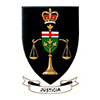Structure and Governance of the Court
Governance of the Court
The Ontario Superior Court of Justice is divided into eight administrative regions - Central East, Central South, Central West, East, Northeast, Northwest, Southwest, and Toronto - and is led by the Executive of the Court.
The Executive of the Superior Court of Justice includes the Chief Justice, the Associate Chief Justice, eight Regional Senior Judges, and the Senior Judge of the Family Court.
The Administration of Justice in Ontario
Canada’s constitutional framework prescribes different roles for the executive, legislative and judicial branches of the government. Each branch of government is separate and independent. The legislative branch makes policy choices, adopts laws and holds the purse strings of government. The executive implements and administers those policy choices and laws with the assistance of a professional public service. The judiciary maintains the rule of law, by interpreting and applying these laws through the independent and impartial adjudication of references and disputes, and protects the fundamental liberties and freedoms guaranteed under the Canadian Charter of Rights and Freedoms.
Canada’s constitutional framework also prescribes separate and independent powers between the federal and provincial governments. While the federal government is responsible for the appointment of Superior Court Judges, the Constitution has charged the provinces with the responsibility for the administration of justice in the provinces. Pursuant to this power, the provincial legislatures enact laws and adopt regulations pertaining to courts, rules of court and civil procedure, or delegate this function to another body. They also pass laws to provide the infrastructure and staff necessary to operate the courts and establish schemes to provide legal representation to persons involved in court proceedings. The provincial legislature votes on the funds necessary to operate the justice system within the province, and the executive, mainly through the office of the Attorney General, is charged with the responsibility of administering these funds and, more broadly, the administration of justice itself.
In 2007, the Ontario Superior Court of Justice and the Attorney General of Ontario entered into an agreement (the Memorandum of Understanding). It sets out the respective roles of the Chief Justice of the Ontario Superior Court of Justice and the Attorney General of Ontario, and the terms under which they have agreed to work together for the administration of justice in Ontario. The agreement recognizes and respects judicial independence and the constitutional framework in which the Attorney General and the judiciary operate as separate and independent branches of government.
